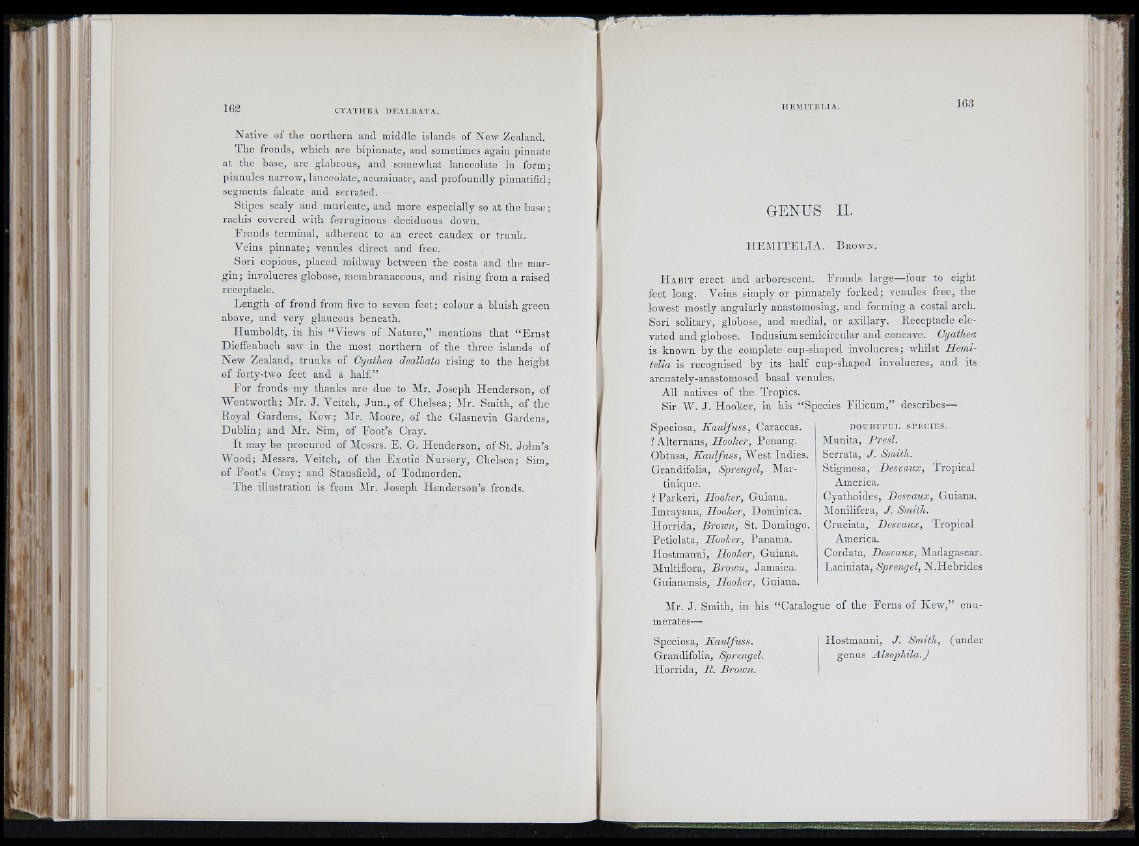
N a tiv e of the n o rth e rn and middle islands of N ew Zealand.
T h e fronds, which are b ip in n a te , and sometimes again pinnate
at th e base, are glabrous, and somewhat lanceolate in form;
pinnules narrow, lanceolate, acuminate, and profoundly pinna tifid ;
segments falcate and serrated.
Stipes scaly and muric ate, and more especially so at the b a se ;
rachis covered w ith ferruginous deciduous down.
F ro n d s termina l, ad h e ren t to an erect caudex or tru n k .
Veins p in n a te ; venules dire c t and free.
Sori copious, placed midway between the costa and th e marg
in ; involucres globose, membranaceous, and rising from a raised
receptacle.
L en g th of frond from five to seven feet; colour a blu ish g re en
above, and ve ry glaucous beneath.
H um b o ld t, iu his “ Views of N a tu re ,” mentions th a t “ E rn s t
Diefienbach saw in th e most n o rth e rn of th e th re e islands of
N ew Z ealand, tru n k s of Cyathea dealhata rising to the h e ig h t
of forty-two feet an d a h a lf.”
Eor fronds my thanks are due to Mr. Jo s ep h H en d e rso n , of
■\Ventworth; Mr. J . Ve itch , J u n ., of Che lsea; Mr. Smith, of the
Koyal Gardens, K ew ; Mr. Moore, of th e Glasnevin Gardens,
D u b lin ; and Mr. Sim, of F o o t’s Cray.
I t may be p ro cu re d of Messrs. E. G. H en d e rso n , o f St. Jo h n ’s
W o o d ; Messrs. V e itch , o f th e E x o tic N u rs e ry , Chelsea; Sim,
of F o o t’s C ray ; and Stansfield, of Todmorden.
T h e illustration is from Mr. Jo s ep h H en d e rso n ’s fronds.
GENUS II.
H E M IT E L IA . B r o w n .
H a b i t erect and arborescent. Fro n d s la rg e—four to eight
feet long. Veins simply or p in n a te ly fo rk ed ; venules free, the
lowest mostly an g u la rly anastomosing, and forming a costal arch.
Sori solitary, globose, and medial, or axillary. Keceptacle elevated
and globose. In d u sium semicircular and concave. Cyathea
is known b y the complete cup-shaped involucres; wh ilst Ilem i-
telia is recognised h y its h a lf cup-shaped involucres, and its
arcuately-anastomosed basal venules.
A ll natives of th e Tropics.
Sir W . J . H o o k e r, in his “ Species F ilicum ,” describes—
Speciosa, K a u lfu s s , Caraccas.
? Alte rn an s, Hooker, P en an g .
Obtusa, K a u lfu s s , “West Indies.
Grandifolia, Sprengel, M a rtinique.
? P a rk e ri, Hooker, Guiana.
Im ray an a , Hooker, Dominica.
H ó r rid a , B row n , St. Domingo.
Petiolata, Hooker, Panama.
Hostman n i, Hooker, Guiana.
Multiflora, B row n , Jamaica.
Guianensis, Hooker, Guiana.
D O U B T F U L S P E C IE S .
M u n ita , Presl.
S e rra ta , J . Smith.
Stigmosa, De svaux, T ropical
America.
Cyathoides, Desvaux, Guiana.
Monilifera, J. Smith.
Cruciata, D e svaux, T ro p ic a l
America.
Cordata, Desvaux, Madagascar.
Laciniata, Sprengel, N .H e b rid e s
Mr. J . Smith, in his “ Catalogue of th e F e rn s of K ew ,” e n u merates—
Speciosa, K a u lfu s s .
Grandifolia, Sprengel.
H o rrid a , 11. B rown.
Hostmanni, J. Sm ith , (u n d e r
genus A lso p h ila .)